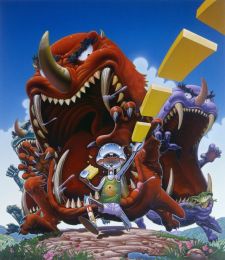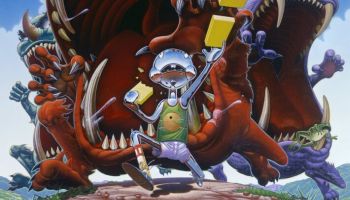 Why?
Why?
Why do some game franchises get forgotten by their publishers? Why would a clump of dirt be important enough to be donated to a museum? And why do some publishers decide to play it safe when deciding on a game’s cover?
All of these questions will be pondered in this edition of Bite-Sized Game History.
![]() You can find a lot of dedicated video game historians on Twitter, and in 280 characters or less, they always manage to unearth some amazing artifacts. Bite-Sized Game History aims to collect some of the best stuff I find on the social media platform.
You can find a lot of dedicated video game historians on Twitter, and in 280 characters or less, they always manage to unearth some amazing artifacts. Bite-Sized Game History aims to collect some of the best stuff I find on the social media platform.
Capcom’s Ghosts N Goblins is celebrating it’s 35th anniversary in 2020, but the franchise hasn’t been seen since the launch of the iOS-exclusive GNG: Gold Knights in 2009 and GNG: Gold Knights II in 2010. Both games were delisted from the App Store in 2016, so we have to go all the way back to 2006’s Ultimate Ghosts N Goblins for the last time Arthur hitched up his boxer shorts and ventured forth to rescue the princess.
So let’s celebrate this anniversary (because it seems unlikely that Capcom will) with a classic piece of promotional art from Ultimate Ghosts N Goblins recently posted by NBA Jam author Reyan Ali.
Classic Capcom promo art for Ghosts 'n Goblins. pic.twitter.com/sK1mMC2aFR
— NBA Jam (the book) (@nbajambook) January 11, 2020
A baggie of dirt is not usually something you’d consider putting in a museum, but you can probably make an exception when it’s dirt from the infamous “Atari Landfill” in New Mexico. Those tiny grains got to mingle with trashed copies of E.T.: The Extra-Terrestrial and Pac-Man, before playing a major part in the story of the American video game industry.
And now, a soil sample from the landfill is being stored in the collection of the International Center for the History of Electronic Games at the Strong Museum of Play.
Andrew Borman, the museum’s the Director of Digital Preservation, had a chance to stare in awe at their specimen, and he shared it with all of us in a recent post:
I looked up items @museumofplay received from Alamogordo because I was curious to see how we cataloged the soil from the landfill. We always put a rationale for why we collected an item, this one is: "This item came to the museum from a landfill in New Mexico." Made me chuckle. pic.twitter.com/Hf1EljrfCj
— Andrew Borman (@Borman18) January 22, 2020
Speaking of Pac-Man, even though the game was a smash hit right from the start, it took a very long time for him to receive a consistent look. This is especially true for the cover art to the Atari 2600 conversion, which went through multiple drafts before it was approved by Atari. Tim Lapetino’s @365ofPac project recently shared a peak at a few of these Pac-Men.
Artist Hiro Kimura’s first attempt really leaned into the horror of Pac-Man‘s premise, refashioning the ghosts as giant beasts and giving Pac-Man himself a metallic makeover. This image was likely a bit too out there for Atari’s executives, so the box was changed to include the more familiar round-body Pac-Man with legs. But even this was deemed inappropriate, and the final cover design featured a flat 2D representation of Pac-Man.
Personally, I wish they had stuck with the original design. I kind of love it and it fits in beautifully with tons of Atari 2600 games that feature very simple graphics and absolutely wild box art.
Day 14: The @atari 2600 #PacMan artwork went through many changes, starting w/ a freewheeling version by artist Hiro Kimura, then evolving to a spherical version seen on most packaging. But execs deemed it not literal enough & added a 2D Pac-Man for more obvious recognition. pic.twitter.com/L8uKiDOw1D
— 365ofPac (@365ofpac) January 14, 2020
I don’t think it’s the first time any of them have been featured on Bite-Sized Game History, but thanks to Reyan Ali, Tim Lapetino, and Andrew Borman for sharing these trivia tidbits. And you can follow me on Twitter for even more game history in 280 characters or less.

